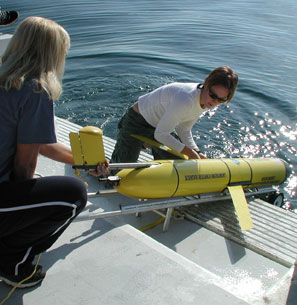You are here: Home › News & Features › New Monitoring Capability to Improve Forecasts of Florida Harmful Algal Blooms
New Monitoring Capability to Improve Forecasts of Florida Harmful Algal Blooms

Last week saw the deployment of two new underwater gliders that can detect blooms of the toxic algae, Karenia brevis , commonly known as “Florida Red Tide.” A collaboration between the National Centers for Coastal Ocean Science's (NCCOS) Center for Coastal Monitoring and Assessment (CCMA) and the Mote Marine Laboratory, the two NOAA gliders join a third glider funded by the State of Florida to begin monitoring for harmful algae using an instrument called the BreveBuster. Use of the BreveBuster on gliders was developed with funding from the NCCOS's Center for Sponsored Coastal Ocean Research (CSCOR), and the current glider project is part of a larger program to improve NOAA's contributions to the Integrated Ocean Observing System by demonstrating effective new monitoring capabilities. The gliders are Slocum gliders, which have no propellers and are capable of remaining deployed unattended for up to three weeks, and are expected to provide key data on bloom locations that will improve the accuracy of NOAA's operational Harmful Algal Bloom Forecast System for Florida. Blooms of Karenia brevis, which Florida routinely experiences, can cause human respiratory distress, toxic shellfish, animal mortality, water discoloration, massive fish kills and losses to the tourism revenues of the state. For more information, contact Richard Stumpf (CCMA) at Richard.Stumpf@noaa.gov , Quay Dortch (CSCOR) at Quay.Dortch@noaa.gov , or Marc Suddleson (CSCOR) at Marc.Suddleson@noaa.gov .Click here to learn more about CSCOR-sponsored efforts to better understand, predict, and mitigate these events.

